Current Status of Coherent Devices:
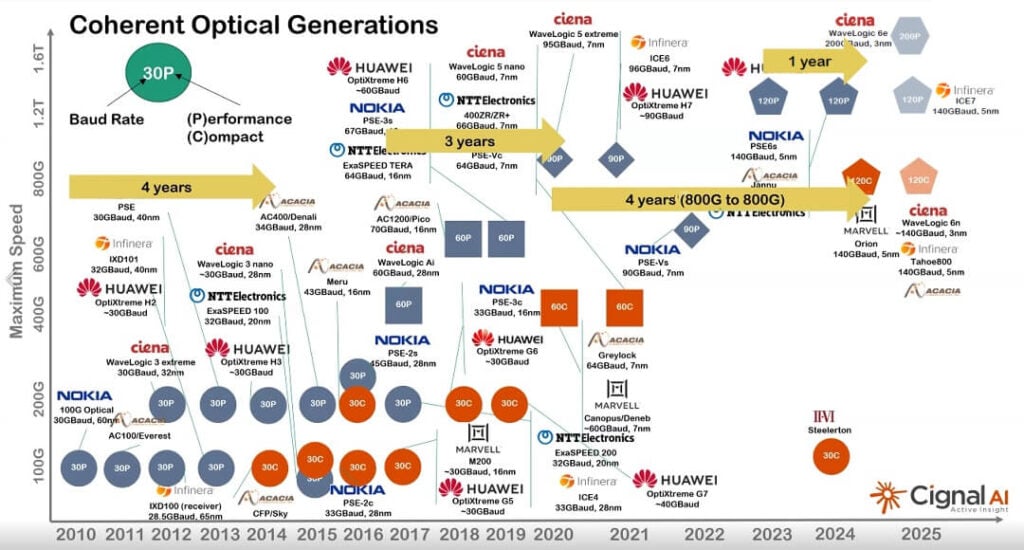
Examining the current state of coherent devices provides insights into the future trends of 800G ZR. Reflecting on the 400G ZR scenario offers valuable reference points:
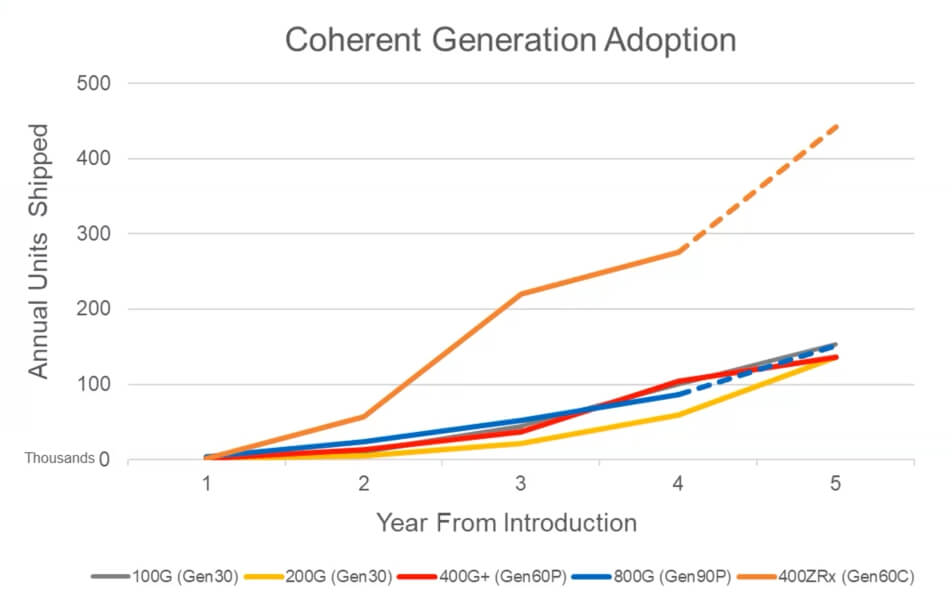
400G ZR: This was the first coherent optical communication technology to be deployed on a large scale in data center communications (datacom) rather than telecommunications (telecom).
Commercial Success: Now in its fourth year of commercial use, the shipment volume of 400G ZR is more than three times that of any other coherent type at a similar maturity level.
Key Factors for 400G ZR’s Success:
- Alignment with Router Data Rates: 400GbE
- Router-Compatible Form Factors: QSFP-DD, OSFP
- Decoupling of Data Center Applications
- Multi-Vendor Ecosystem
For 800G to achieve rapid deployment, it will need to follow a similar path.
However, 800G has its unique characteristics:
Extended Standards
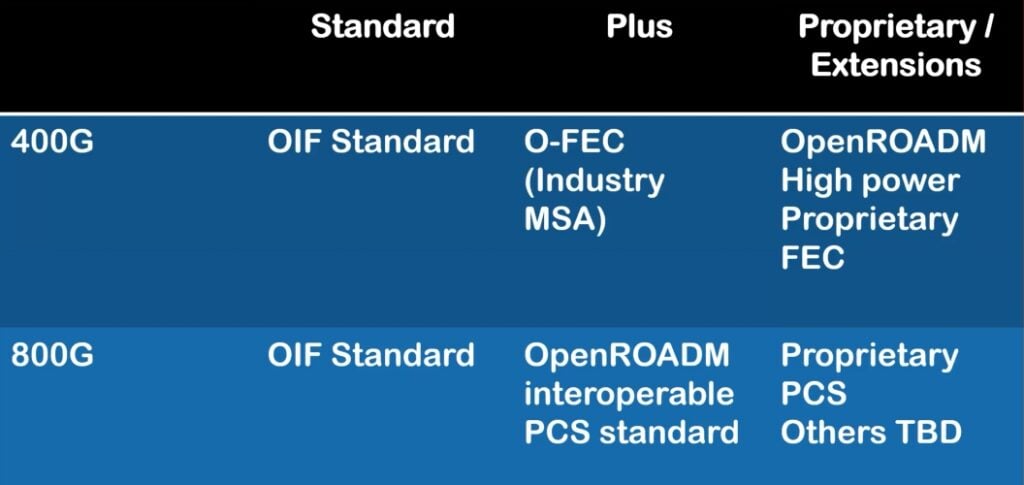
Demand Dynamics: For 400G applications, the shipment volumes of 400G ZR+ and 400G ZR are roughly equal. Currently, the demand for 800G ZR+ is higher than for 800G ZR, despite their nearly identical BOM costs.
Application Scenarios for 800G ZR
Metro Data Center Interconnect (DCI):
While 400G ZR technology is already used to connect large data centers, the market opportunity for 800G in this application may not be as significant.
400G Long-Haul (400G-LH / Gen120):
Utilizes QPSK or 8-QAM modulation techniques to cover longer distances, primarily in the Chinese market.
800G Long-Haul (800G ZR+):
The interoperable PCS standard has opened the market for 800G ZR+ technology, with significant support from Meta.
400G Interoperability Mode:
Some hyperscale data centers require this mode to ensure forward compatibility.
Market Forecast for 800G ZR
Initial Shipments: Expected this year, with major volumes in 2024 and 2025.
Key DSP Manufacturers: ZTE, Ciena, Nokia, Infinera, Cisco/Acacia, among others, are collaborating in this space.
Additional Insights:
400G Long-Haul (QPSK, 8QAM): Popular in China (CFP2 packaging), but less interest from hyperscale data centers or Western service providers.
800G Data Center Interconnect (DCI) (QSFP/OSFP): Market predictions depend on the demand from leading hyperscale data centers like Meta and Google. Microsoft, the largest user of 400G ZR, will not adopt this technology.
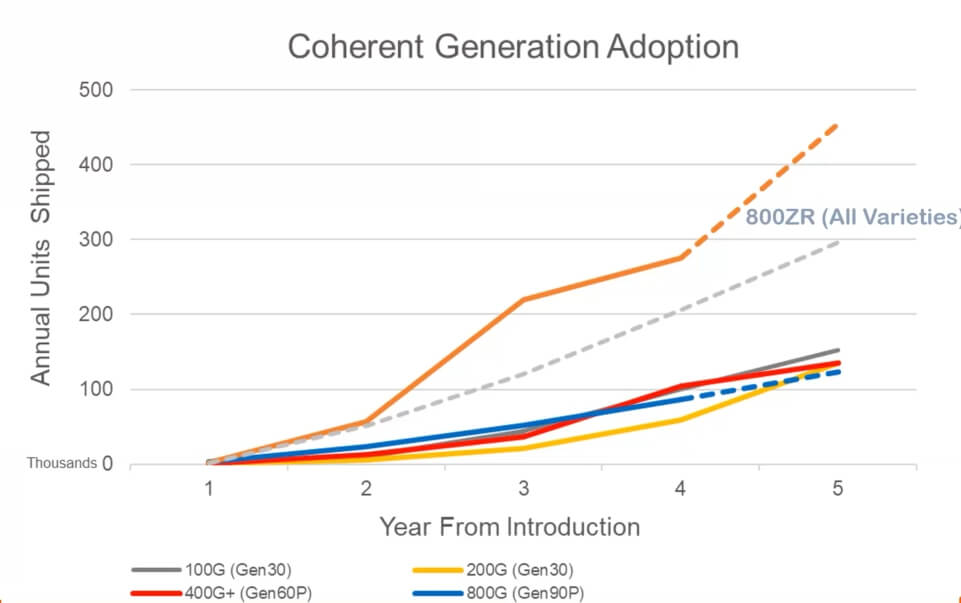
Google’s Perspective on 800G:
Illustrations of ZR/ZR+ Network Configurations in Google Optical WAN Network:
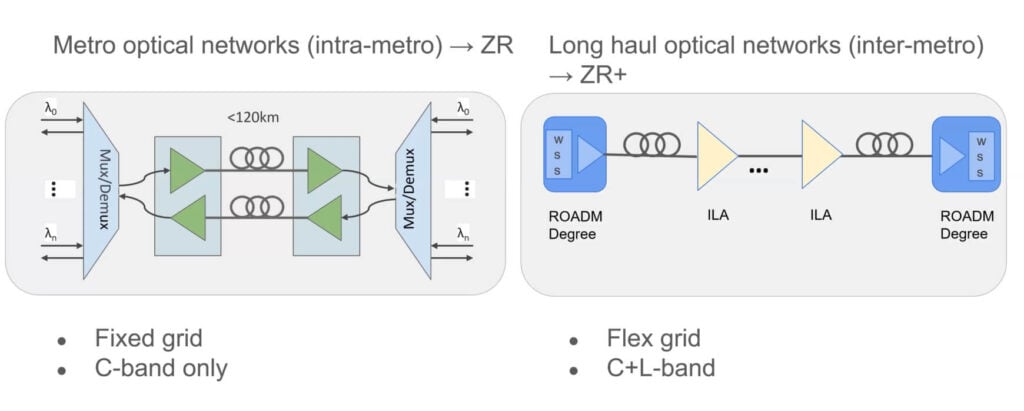
Review of 400G ZR Deployment in Metropolitan Networks:
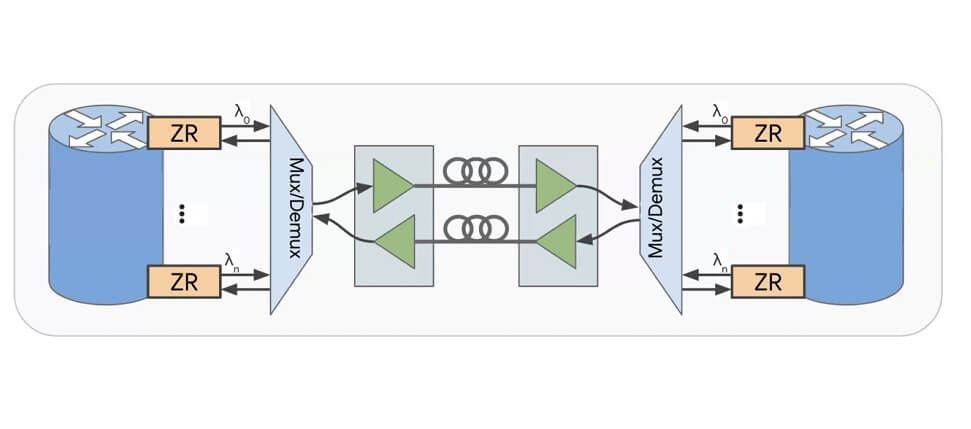
Success Factors for 400G ZR Metropolitan Deployment:
- Significant cost reduction.
- Savings in rack/space/power (RSP) resources.
- Simplified deployment and maintenance.
Future Developments:
- Evolution towards 800G ZR technology in metropolitan networks.
- Extension of 400G/800G coherent pluggable technology to long-haul (inter-city) networks.
Google’s Definition of Long-Haul Coherent Pluggable ZR+:
What is ZR+?
According to Google, ZR+ refers to pluggable modules capable of long-distance transmission (approximately 1000 kilometers) with high output power.
Requires tunable C/L bands and high output power to work with long-haul line systems.
The coverage of 400G OpenZR+ is insufficient (approximately 500 kilometers).
800G can be based on the OpenROADM PCS standard or proprietary encoding schemes.
Why Do We Need ZR+?
The significant increase in long-haul WAN capacity demand, partly driven by machine learning (ML). ZR+ is the preferred solution.
Lower cost compared to embedded coherent solutions.
Savings in rack/space/power (RSP) resources, eliminating the constraints of physical infrastructure.
Rapid service provisioning.
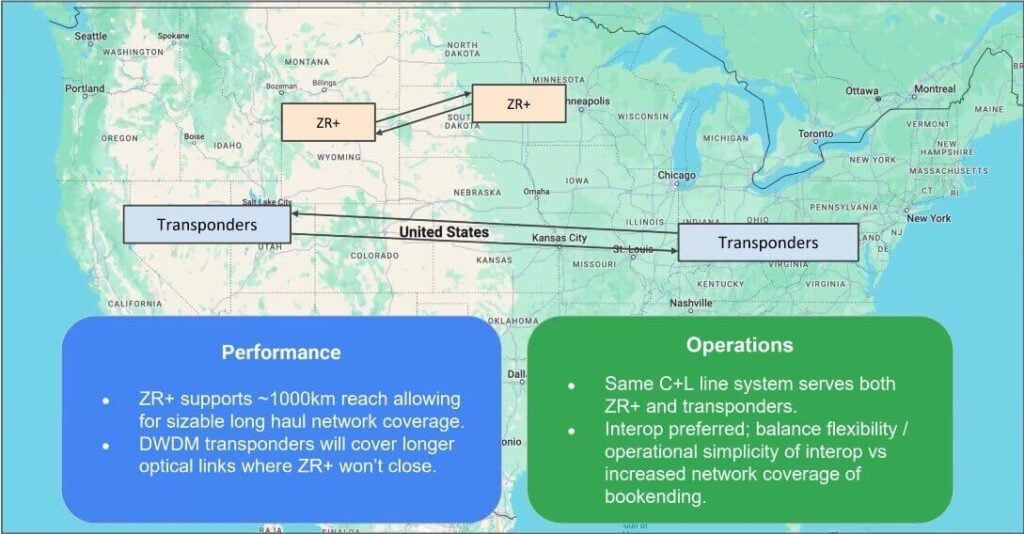
Google’s Goals:
Achieve universal operation of ZR/ZR+ modules from different vendors on multiple router platforms.
Support for ZR+ on Router Platforms:
Hardware (HW) needs to support higher ZR+ module power consumption (power supply/cooling).
Software (SW) needs to support ZR+ (OpenConfig, independent of router/module vendors).
Field Firmware (FW) Upgrades:
Field firmware upgrades for ZR/ZR+ are necessary.
Universal Standards Across Platforms and Optical Module Vendors:
Google is actively promoting the pluggable firmware upgrade project within OIF.
Importance of Backward Compatibility:
Backward compatibility for upgrades from 400G to 800G is crucial.
Ciena’s Perspective on 800G ZR:
Filling Gaps and Expanding Applications Previously Addressed by 400G ZR:
- Ciena categorizes 400G ZR based on TX output power into three classes:
Class A: Built-in amplification, output power > -2dBm.
Class B: Optional built-in amplification, output power -7dBm.
Class C: No built-in amplification, output power -10dBm.
- Ciena prefers the Class A downward-compatible solution, covering most scenarios.
Emphasis on Probabilistic Constellation Shaped Modulation (PCS):
PCS technology is used to extend transmission distance.
Ciena’s WL5n 400G 70GBd PKT-MAX product uses PCS, doubling the 400G transmission distance compared to the 60Gbd 400G ZR+ solution.
- Features of Next-Generation Pluggable Optical Modules:
Open ROADM defines interoperable PCS modes for 600G and 800G.
Ciena’s digital signal processor (DSP) supports interoperable PCS and higher performance modes.
800G coherent pluggable optical modules in C and L bands are needed to improve spectral efficiency.
Link encryption functionality is required. Ciena is actively discussing data path encryption with some customers and provides encryption capabilities in C and L bands within its ASIC/DSP.
- OIF’s new 800G LR is another key application area for coherent optical modules.
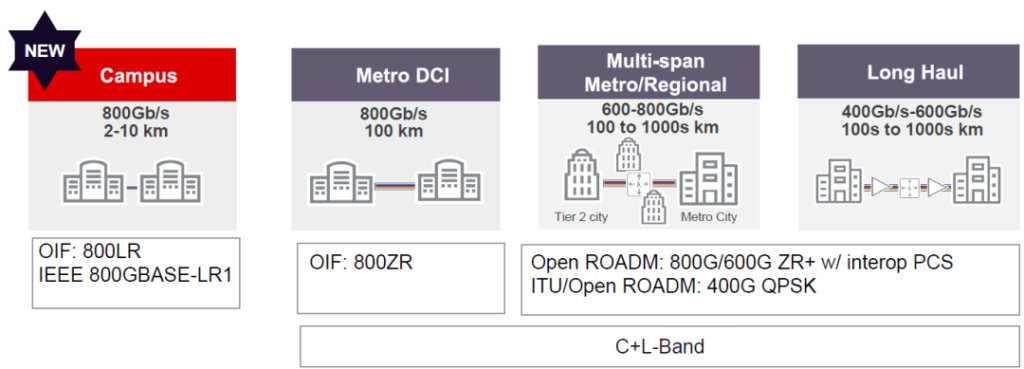
Ciena’s WaveLogic 6 Nano Technology and Its Innovations in Optical Communication
Source: Ciena’s Official Website and Related News Reports
Utilizes state-of-the-art 3nm CMOS technology and electro-optical devices with 70 GHz bandwidth.
Supports OSFP Type 2A and QSFP-DD800 packaging formats.
Complies with standard 800G ZR/800LR/800G ZR+ (interoperable PCS) modes.
Capable of delivering maximum performance in 400G/600G/800G PCS transmission modes, with rates up to 141GBd.
Employs SOA-on-SiP heterogeneous integration technology to achieve high Tx output power and scalability in both C-band and L-band.
Meets the OIF 800G ZR Tx output Class A standard.
Spectral and Constellation Diagrams
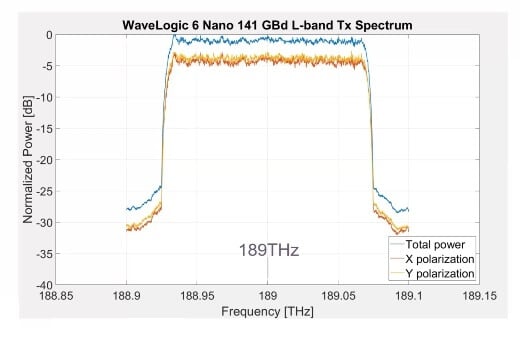
Note: WaveLogic 6 Nano is a registered trademark of Ciena.
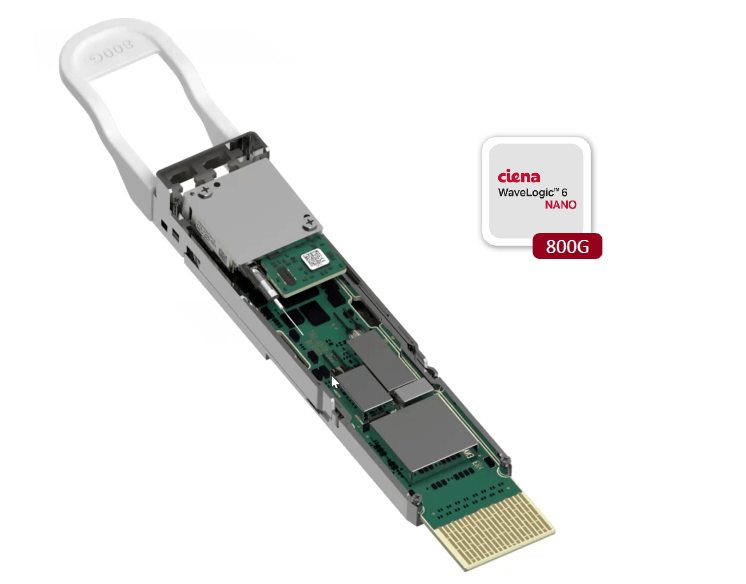
Network Evolution from 400G ZR to 800G ZR
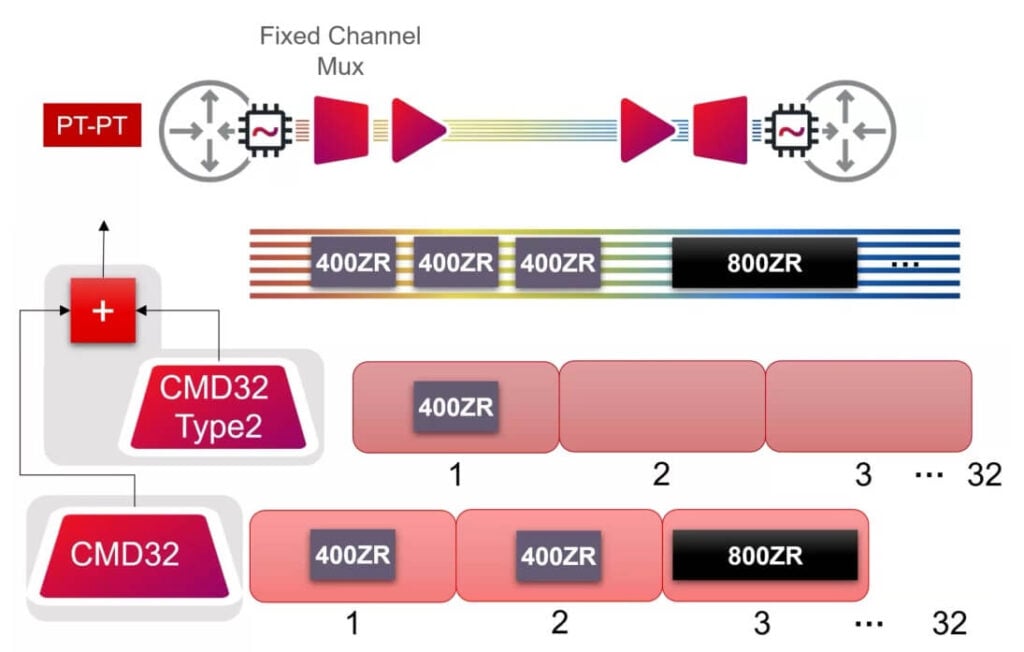
Introduced a new fixed channel multiplexer/demultiplexer (CMD32s) suitable for both 400G ZR and 800G ZR. This solution combines the simplicity, cost-effectiveness, and performance of fixed PT-PT solutions, offering support for two generations of ZR technology.
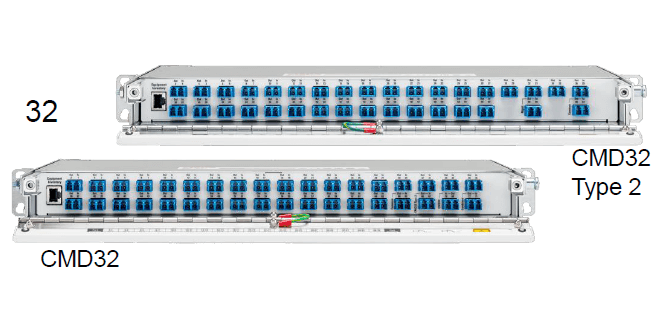
Ciena’s network solutions can extend 800G transmission distances to over 1000KM.

Access to all pluggable features from the router is a mandatory requirement.
Industry-standard management methods are being researched within OIF (Optical Internetworking Forum) and IETF (Internet Engineering Task Force) to achieve “Plug and Play.”
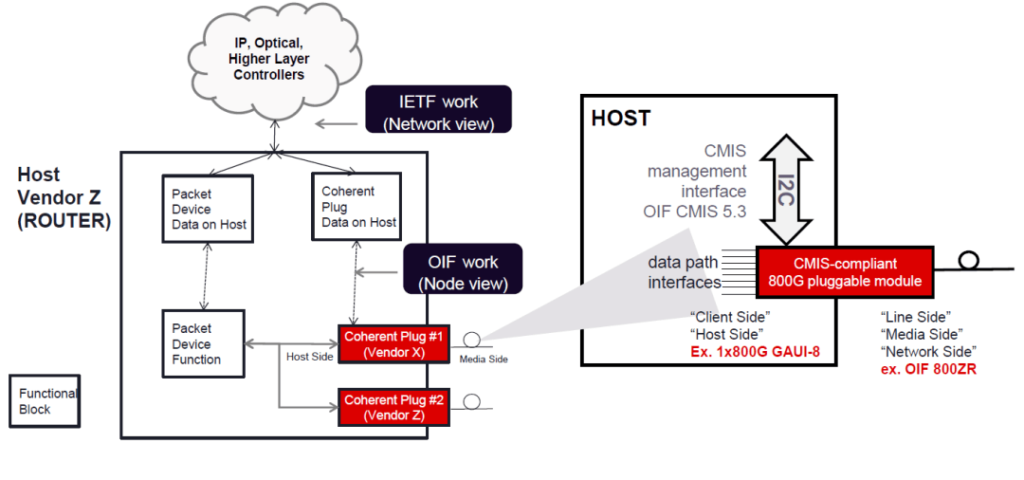
Ciena Key Points Summary:
New Features of 800G Pluggable Modules:
The 800G pluggable modules include new features that help expand the market.
Ciena’s WaveLogic 6 Nano:
Ciena’s WaveLogic 6 Nano technology uses a 3nm process, providing a data rate of 141GBd, supporting both C-band and L-band, making it the best choice in terms of performance, power consumption, and scalability.
Ciena’s Line System:
Ciena’s line system fully supports multiple generations of pluggable modules, ensuring compatibility and upgradeability of the technology.
Network Coverage Performance:
The network coverage performance of the 800G pluggable modules can support transmission distances of over 1000 kilometers.
Network Management and Operationalization:
To achieve the simplicity of “Plug and Play,” the industry needs to promote relevant management and operationalization standards.
- The DCI box will be replaced, and IP over DWDM will become mainstream.
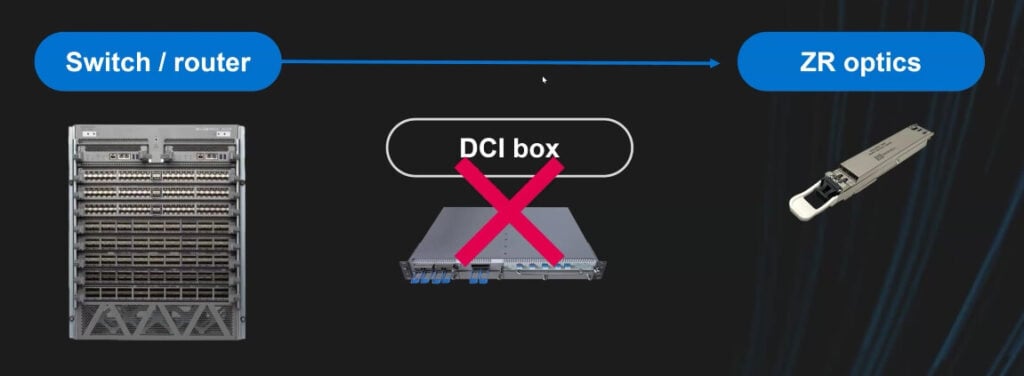
- There are already three generations of coherent products, with a reduction in equivalent unit power consumption. The ZR/ZR+ products have been announced to be operational in the market, with a cumulative runtime exceeding 10 billion hours.
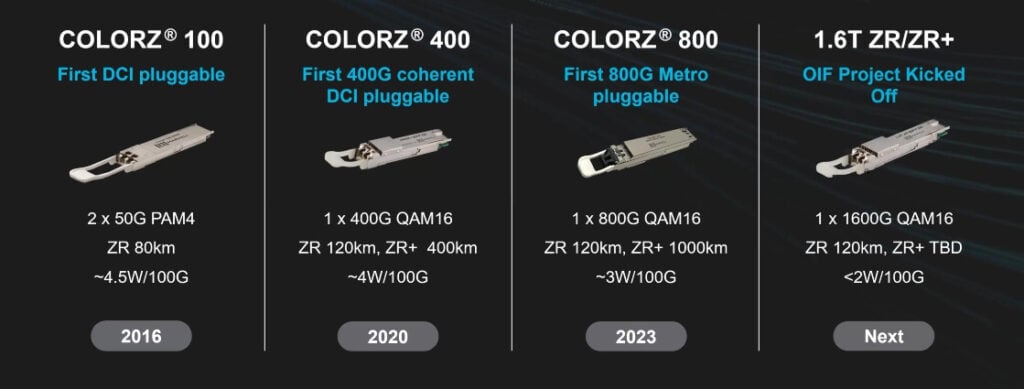
- Some features of the ColorZ 800 module
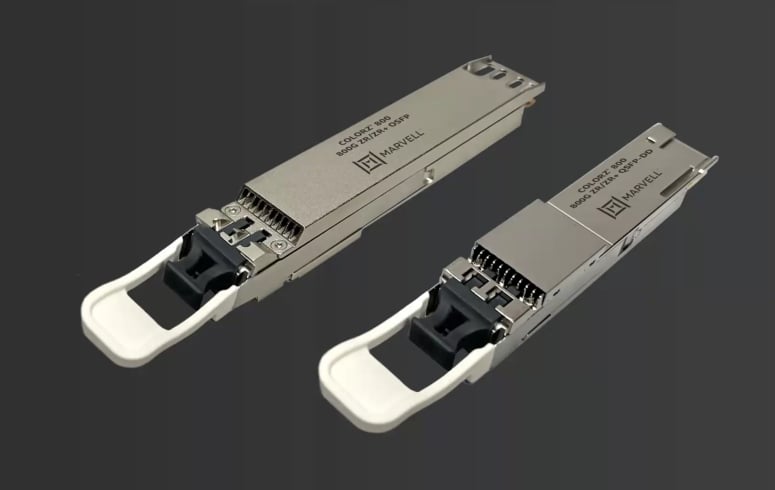
- Multi-vendor interoperability, including host and media/line-side interconnectivity.
- Multi-mode support: including 400G, 600G, and 800G.
- Multi-distance coverage: from 120 kilometers to over 2000 kilometers.
- C+L band: at 800G/λ, each fiber can achieve a transmission rate of 51.2Tb/s.
- Adjustable optical output power: up to +1dBm.
- Supports C-CMIS.
- Proven third-generation DSP, SiP, and modules.
- Full-chain electronic chip supply capability from DSP driver TIA to module, with device bandwidth for 800G exceeding 70GHz.
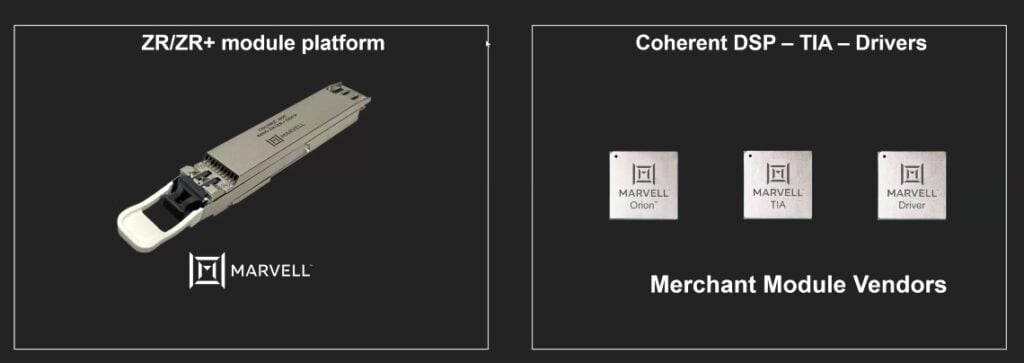

Rough comparison of transmission capabilities and modulation formats.
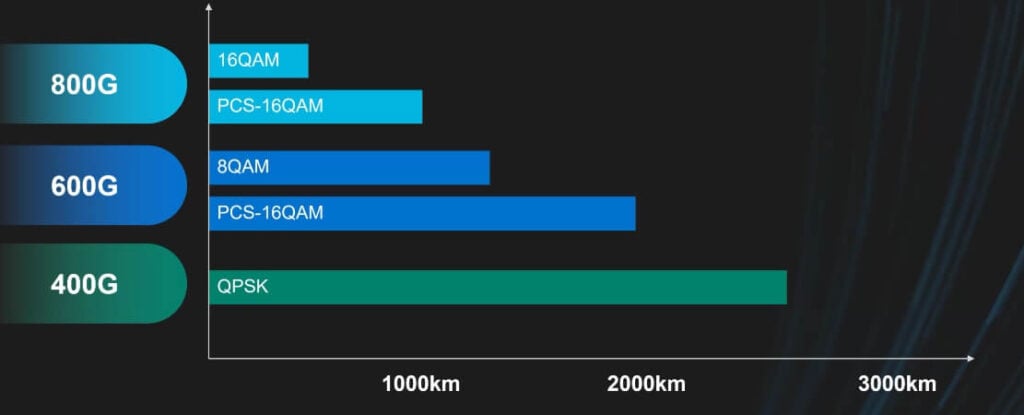
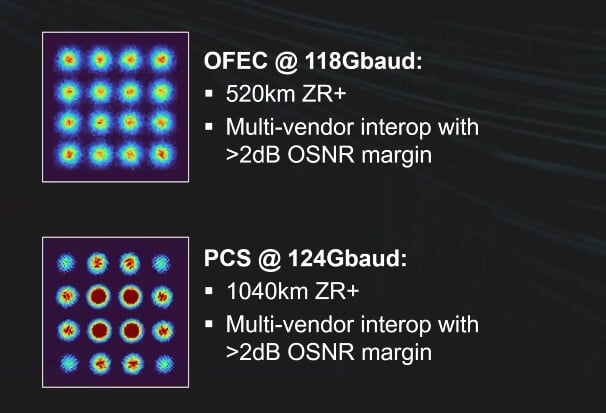
Some examples of constellation diagrams.
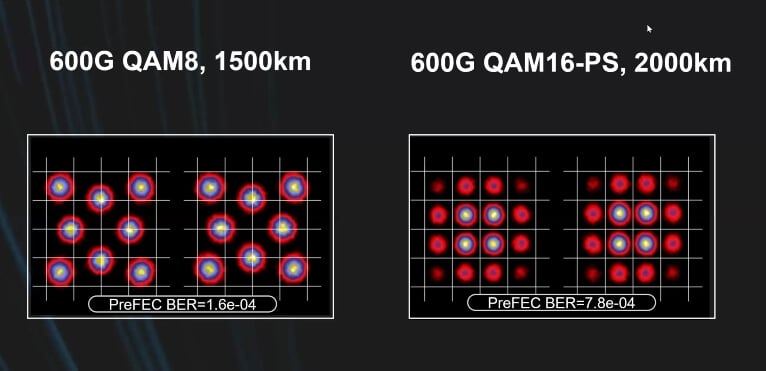
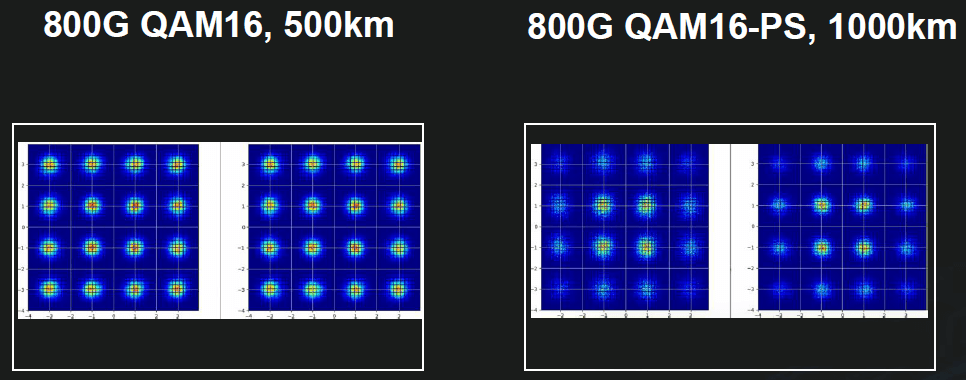
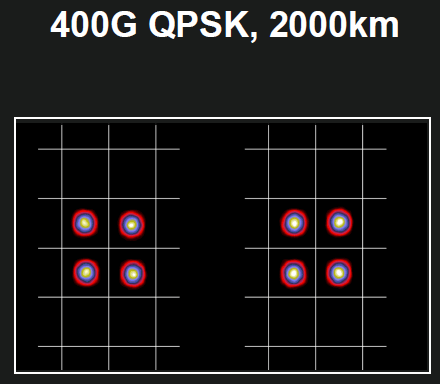
Related Products:
-
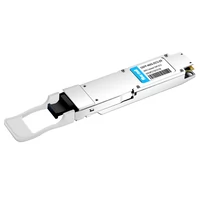 OSFP-400G-DCO-ZR 400G Coherent OSFP-DCO ZR C-band Tunable Optical Transceiver Module
$7000.00
OSFP-400G-DCO-ZR 400G Coherent OSFP-DCO ZR C-band Tunable Optical Transceiver Module
$7000.00
-
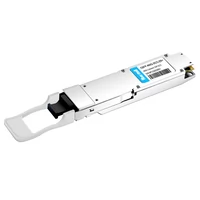 OSFP-400G-DCO-ZR+ 400G Coherent OSFP-DCO ZR+ C-band Tunable Optical Transceiver Module
$7000.00
OSFP-400G-DCO-ZR+ 400G Coherent OSFP-DCO ZR+ C-band Tunable Optical Transceiver Module
$7000.00
-
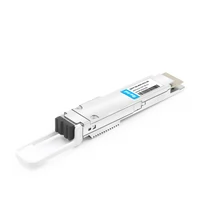 QSFP-DD-400G-DCO-ZR 400G Coherent QSFP-DD DCO C-band Tunable Optical Transceiver Module
$6500.00
QSFP-DD-400G-DCO-ZR 400G Coherent QSFP-DD DCO C-band Tunable Optical Transceiver Module
$6500.00
-
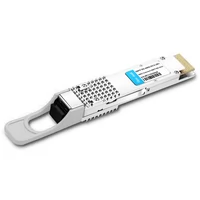 QSFP-DD-400G-DCO-ZR+ 400G Coherent QSFP-DD DCO C-band Tunable Optical Transceiver Module
$7000.00
QSFP-DD-400G-DCO-ZR+ 400G Coherent QSFP-DD DCO C-band Tunable Optical Transceiver Module
$7000.00
-
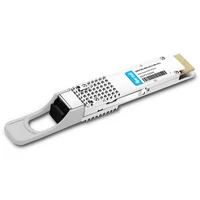 QSFP-DD-400G-DCO-ZR+-HTx 400G Coherent High TX Power QSFP-DD DCO OpenZR+ C-band Tunable Optical Transceiver Module
$9000.00
QSFP-DD-400G-DCO-ZR+-HTx 400G Coherent High TX Power QSFP-DD DCO OpenZR+ C-band Tunable Optical Transceiver Module
$9000.00
-
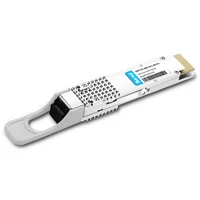 QSFP-DD-400G-DCO-ZR-HTx 400G Coherent High TX Power QSFP-DD DCO ZR C-band Tunable Optical Transceiver Module
$8500.00
QSFP-DD-400G-DCO-ZR-HTx 400G Coherent High TX Power QSFP-DD DCO ZR C-band Tunable Optical Transceiver Module
$8500.00
